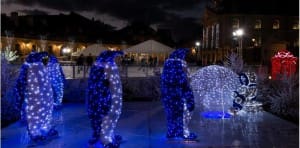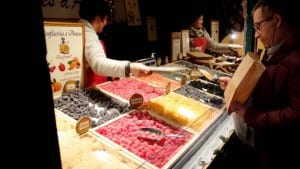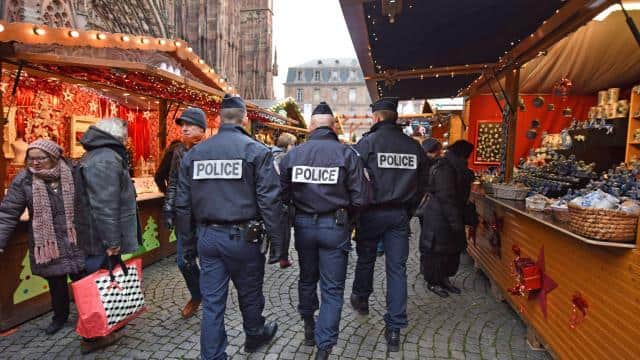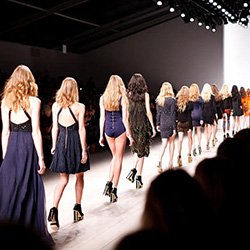With the upcoming events and celebrations for the end of the year, I would like to present how Dijon is celebrating them.France is historically a catholic country, so Christmas is a much more meaningful event for believers here. During this period of the year, religious authorities usually organize two mass: one on the 24th of December and one the day following. Additionally, they decorate churches (such as Notre-Dame de Dijon) with a traditional small size scale reproduction of the Nativity scene.
However, France is a very cosmopolitan country, and a lot of people are atheists or believers of another religion (muslims, buddists…). Those people view Christmas more as a commercial celebration. Even though they are not believers, they can celebrate Christmas and offer presents to their friends. Santa Claus is still a reassuring figure and an icon for children, whether they grew up in a Christian family or not. In France, there are two ways of celebrating Christmas and New Year’s Eve, especially for youngsters. They usually spend Christmas with the family, and the New Year’s Eve with friends. Christmas is the occasion to gather the whole family for two or three days of celebration and traditional dishes. In France, we usually eat foie gras, salmon or snails as an appetizer. Depending on the family and the region, the main dishes vary. However, the traditional dessert is the famous Bûche de Noël (literally Christmas log, or Christmas roll cake), which is the representation of an old superstition. A long time ago, a sturdy log was put in the chimney for Christmas, and was supposed to burn slowly until the New Year’s Eve. If it was the case, it would mean that harvests for the next year would be good. The Bûche de Noël is a vestige of this superstition. It is usually made of chocolate or of fruits, and is eaten both for Christmas and for New Year’s Eve.

Even for non-Christians, Christmas is generally a unique occasion to reunite the family and to spend a good time altogether. As mentioned before, the New Year’s Eve is much more spent with friends, and often outside. Usually, youngsters start the party at night in a private committee, in a house or an apartment, and will go outside later on in restaurants, bars, night clubs, or in the streets to celebrate with strangers. For the occasion, special events are organized, such as concerts, public parties, and, of course, the traditional New Year fireworks show. People are usually cold and distant to strangers, but the New Year’s Eve generally tends to bring people together. As for Dijon in particular, the city as a whole is decorated for the celebrations of the end of the year. Various places in the city even propose thematic events and constructions.For example, the Place de la République is usually welcoming the Christmas market and a big wheel. It is similar, in a lesser extent, to the Christmas market near the Sky building and the Hep 5 wheel of Umeda, in Osaka. The Place de la Libération usually welcomes a skating rink for Christmas and the New Year’s Eve. A small polar landscape is also reproduced for the occasion. Every year, during the night of Christmas Eve, a man disguised as the Santa Claus can be seen climbing the city hall for a special event.
 Decorations on Place de la Libération, Dijon
Decorations on Place de la Libération, Dijon A candy shop in the Christmas market
A candy shop in the Christmas market Policemen patrolling in the Christmas market
Policemen patrolling in the Christmas marketAs you can see on the picture above, security has been reinforced in response to the tragic events of Paris in mid-November. Various events have been cancelled due to safety problems ever since. But despite the terrorist threat that is more real than ever, French people want to carry on and to celebrate the end of the year like usual, to prove that they are not afraid, and that their lives should not be altered.

 Decorations on Place de la Libération, Dijon
Decorations on Place de la Libération, Dijon A candy shop in the Christmas market
A candy shop in the Christmas market Policemen patrolling in the Christmas marketAs you can see on the picture above, security has been reinforced in response to the tragic events of Paris in mid-November. Various events have been cancelled due to safety problems ever since. But despite the terrorist threat that is more real than ever, French people want to carry on and to celebrate the end of the year like usual, to prove that they are not afraid, and that their lives should not be altered.
Policemen patrolling in the Christmas marketAs you can see on the picture above, security has been reinforced in response to the tragic events of Paris in mid-November. Various events have been cancelled due to safety problems ever since. But despite the terrorist threat that is more real than ever, French people want to carry on and to celebrate the end of the year like usual, to prove that they are not afraid, and that their lives should not be altered.






























































